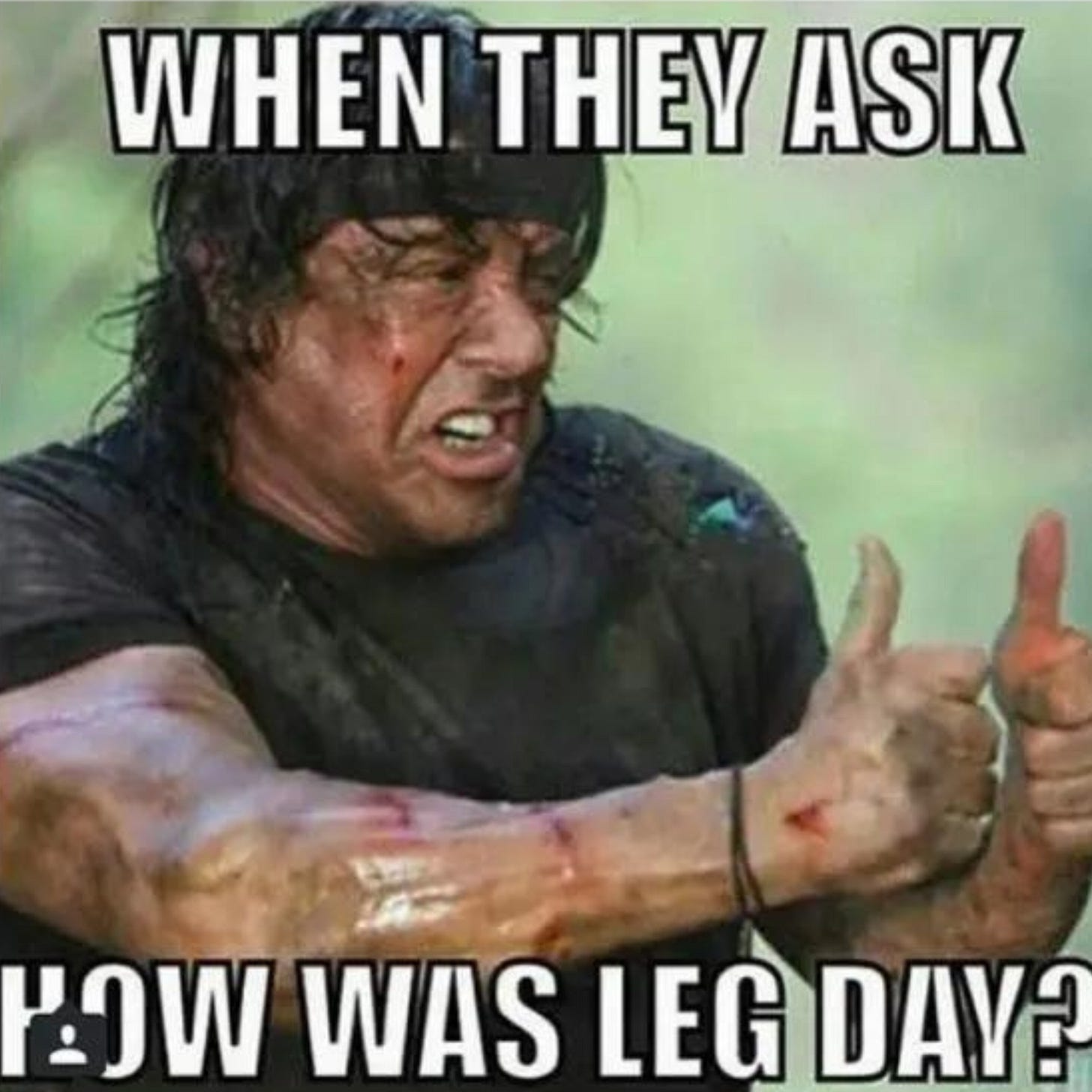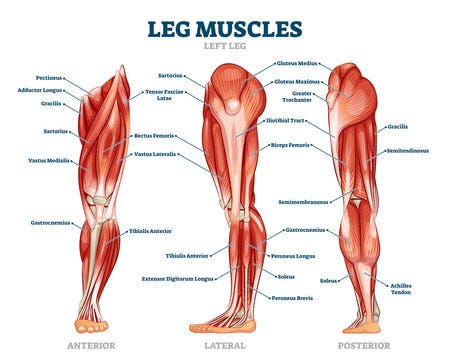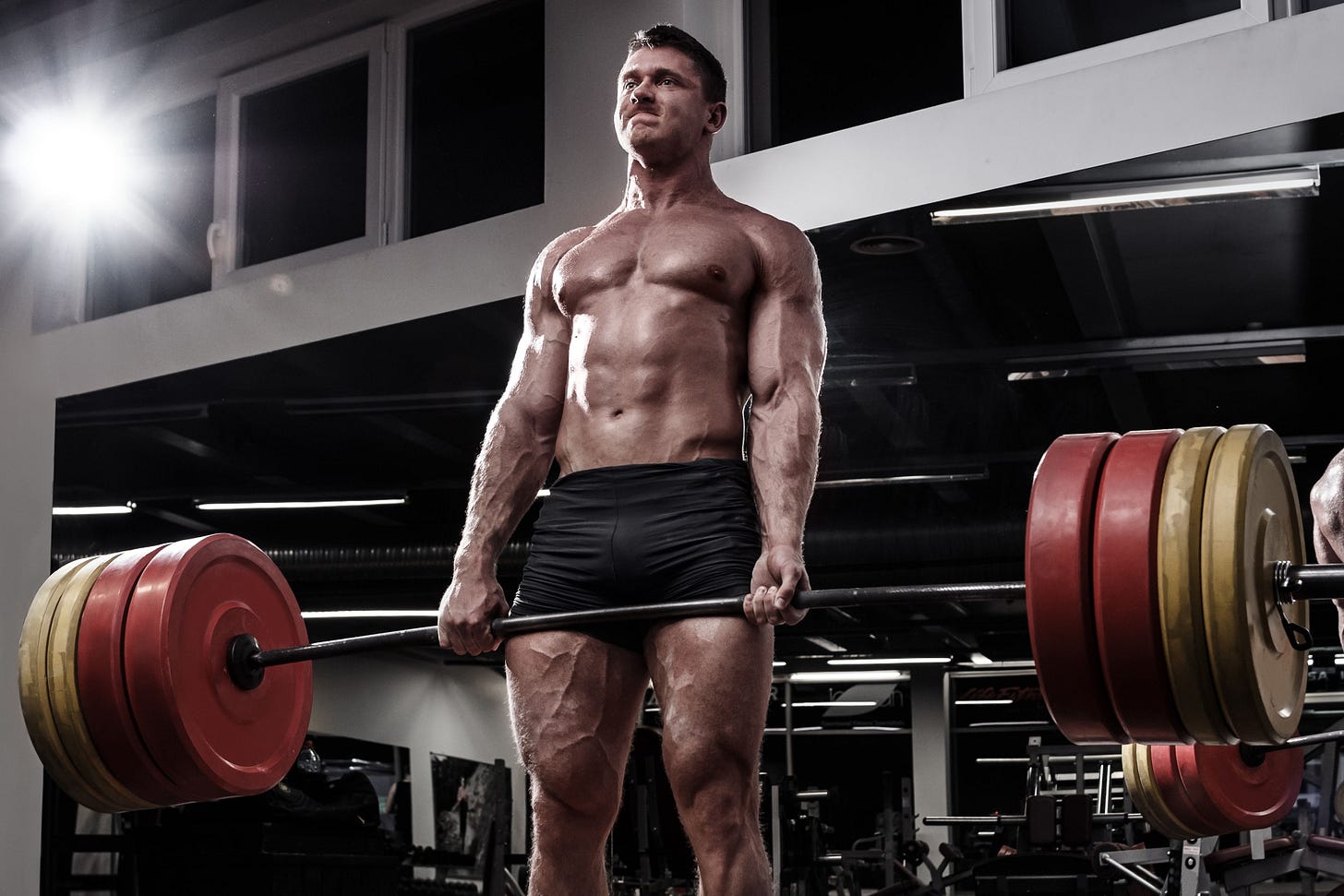Leg Day Routines for Muscle, Strength, & Fat Loss
Friends don't let friends skip leg day
In this article:
Three reasons why Leg Day is the toughest day in the gym
Criteria for a balanced Leg Day
Common Leg Day exercise options
Four balanced Leg Day routines for multiple demographics
Memes.
Leg Day is a monster day throughout the wide world of weightrooms. A proper Leg Day works the muscles between your ankles and the top of your hips. Intense lifters talk about Leg Day as if they’re going into a life-or-death battle. They brag about working so hard that they can’t properly navigate the stairs on their way out of the gym. It’s the stuff gym memes are made of, and I can appreciate that.
A well-executed Leg Day is truly the most challenging day of the average training program.
Meme time! This first one had me crack’n up and you just know the last one’s the truth.
Leg Day is interesting because most people find it unpleasant at first, but as they push through the pain and misery and start making lower body progress, it becomes something they look forward to. For some, Leg Day even becomes the training day they look forward to the most.
You might even be one of these people. I know I am. Did you hate Leg Day in the beginning, but now love it? If this is you, tell me why you fell in love with Leg Day.
Why Is Leg Day So Tough?
Why do people treat it like an event? Why is it the universally accepted hardest training day?
In my opinion, it comes down to three reasons:
Leg Day requires the use of large muscles/muscle groups.
Leg Day exercises require relatively heavy weights.
Leg Day causes pain throughout large areas of the body.
Here’s my plan for the rest of this article; I’m going to talk about each of my three reasons above and then give you my recommended Leg Day exercises, along with some sample Leg Day routines for you to try out. OK, let’s hash out these reasons.
1. Leg Day Requires the Use of Large Muscles/Muscle Groups
From an anatomical perspective, it’s undeniable that the leg muscles are some of the biggest in our bodies. In fact, the Gluteus Maximus is the largest muscle in the body and of the top five largest muscles, leg muscles make up three. On average, the largest muscles in the body are the Glutes, Quads, Hamstrings, Lats, and Pecs.
Not only are the major muscles of the legs the largest in the body, they’re also all worked on Leg Day. Sure, you can have specialized Hamstring-focused Leg Days or Quad-focused Leg Days, but if you’re using compound lower body exercises within those days, the Glutes, Quads, and Hamstrings are all going to activate to some degree.
So why does muscle size matter when it comes to how challenging a training day feels? Well, muscles require energy to work, and our bodies need to produce that energy, on-demand, during exercises. The bigger the muscle being used, the more energy we need to produce for it work and the more resources we’re going to use up in doing so.
These processes are draining and demanding for our bodies regardless of what muscle groups we’re working, but they’re most crushing when we invite our largest muscle groups to the party.
2. Leg Day Exercises Require Relatively Heavy Weights
The strength hierarchy is very consistent among us humans. I laid out the top five largest muscle groups in our bodies, but now I want to list out, in order from heaviest to lightest, the loads we can lift for common ‘standards of strength’ exercises.
Deadlift > Squat > Bench Press > Row > Overhead Press
As you can see, the first two exercises are lower body exercises. Deadlifts hit Glutes and Hamstrings very hard and Squats target Quads and Glutes as their primary areas of focus. This is exactly why I mentioned Leg Day requiring relatively heavy weights. Compared to any upper body compound exercise, lower body compounds should require more weight if your strength levels are balanced from head to toe.
Heavier weight makes things harder because, well, it’s heavier. But Leg Day isn’t so tough just because the weights are heavier; it also has to do with the nature of lower most lower body exercises. To be most precise, it’s about how we hold the weight and need to support it through each rep’s range of motion.
With lower body compounds like Squats, Deadlifts, and Lunges, it’s just you and the weight. It’s either on your back or in your hands and there’s often nothing providing you with extra support.
This means your body will be not only be demanding plenty of energy production to move the heavier weight needed to challenge those big leg muscles, but it will also be calling your core muscles and other muscles of your upper body into the mix to keep the weight where it’s supposed to be while you do your reps. Those muscles require energy to work, too.
Let’s take the Deadlift as an example. While the bulk of the work is done by your lower body as you complete each rep, you need your forearm and hand muscles firing to hold onto the bar, your ab and spinal erector muscles need to statically flex for strong bracing at all times, and your upper back muscles need to remain tight so your upper body doesn’t fold like a wet noodle as you flex your glutes forward and drive your torso to the upright position.
To finish up this point, the requirement of relatively heavy weights during Leg Day is reason enough to make it the most challenging training day. Adding the involvement of auxiliary muscle groups elevates it to stuff memes are made of.
There’s a reason people get anxious for Leg Day. It’s hard as hell.
3. Leg Day Causes Pain Throughout Large Areas of the Body
Muscle burn is part of intense training. It just is. It stands to reason that if a larger area of your body is burning, there’s more pain to tolerate and it’ll be harder to mentally push through.
As we learned earlier, the largest muscles in your body are found in your legs, so the area of burn on Leg Day is going to be big…and painful. This is the third reason why Leg Day is so tough, and it can’t be ignored. The more you’re willing to endure some muscle-burning pain, the harder you’ll be able to push during all of those high-quality leg exercises.
Let’s recap; Leg Day earns its reputation as the most challenging training day because it works the largest muscles, it requires the heaviest weight loads, and the burn is felt throughout massive areas of the body.
Criteria for a Balanced Leg Day
Let’s move on from training talk and get into the criteria for a balanced and effective Leg Day.
Include a Quad-focused compound exercise.
Include a Glute/Hamstring-focused compound exercise.
Include a unilateral lower body compound exercise.
Include a Quad isolation exercise.
Include a Hamstring isolation exercise.
Include a Calf isolation Exercise
As you can see, this list of criteria covers the major muscle groups of the lower body. Quads, Glutes, Hamstrings, and Calves are activated through multiple exercise types.
Exercise Options
This article is titled Leg Day Basics for Beginners, so I’d like to list out a handful of exercise options for each criteria point above. This will give you multiple options, which is helpful in creating variety in your Leg Days.
Quad-Focused Compound Exercise Options
Barbell Squat
Barbell Front Squat
Cambered Barbell Squat
Belt Squat
Hack Squat
Machine Squat
Leg Press
Glute/Hamstring-Focused Compound Exercise Options
Conventional Deadlift
Sumo Deadlift
Romanian Deadlift
Low Bar Good Morning
Roman Chair Hyperextension
Angled Hyperextension
Glute Ham Raise
Hip Thrust
Unilateral Lower Body Compound Exercise Options
Walking Lunge
Stationary Lunge
Reverse Lunge
Bulgarian Split Squat
Single-Legged Squat
Step Up
Quad Isolation Exercise Options
Leg Extension
Sissy Squat
Hamstring Isolation Exercise Options
Lying Leg Curl
Seated Leg Curl
Kneeling Leg Curl
Nordic Leg Curl
Calf Exercise Options
Standing Calf Raise Machine
Leg Press Calf Raise
Donkey Calf Raise
Seated Calf Raise
Of course, there are many more exercise options than I’ve listed above. But again, this article is meant to provide you with basic foundational principles and options for putting together a killer Leg Day.
When the time comes to introduce exercises that aren’t included in my lists, just make sure they fit the category you’re placing them in. For example, replace a Quad-focused compound exercise with another Quad-focused compound exercise.
Do you have an exercise you like, but it’s not on my lists? Leave me a comment and I’ll give you my thoughts on where it fits into your routine.
Sample Leg Day Routines
If you ask me, this is the most valuable portion of this article. I’m going to lay out specific sample routines and you can choose to use the one you like the most.
Note: When possible, follow the order of the exercises as they’re listed for each routine.
If you’re paying attention, you’ll notice how these routines follow my criteria list for a balanced Leg Day.
The Classics
These two routines take the OG Leg Day exercises and put them to damn good use! You will not be short of results with these reliable setups.














